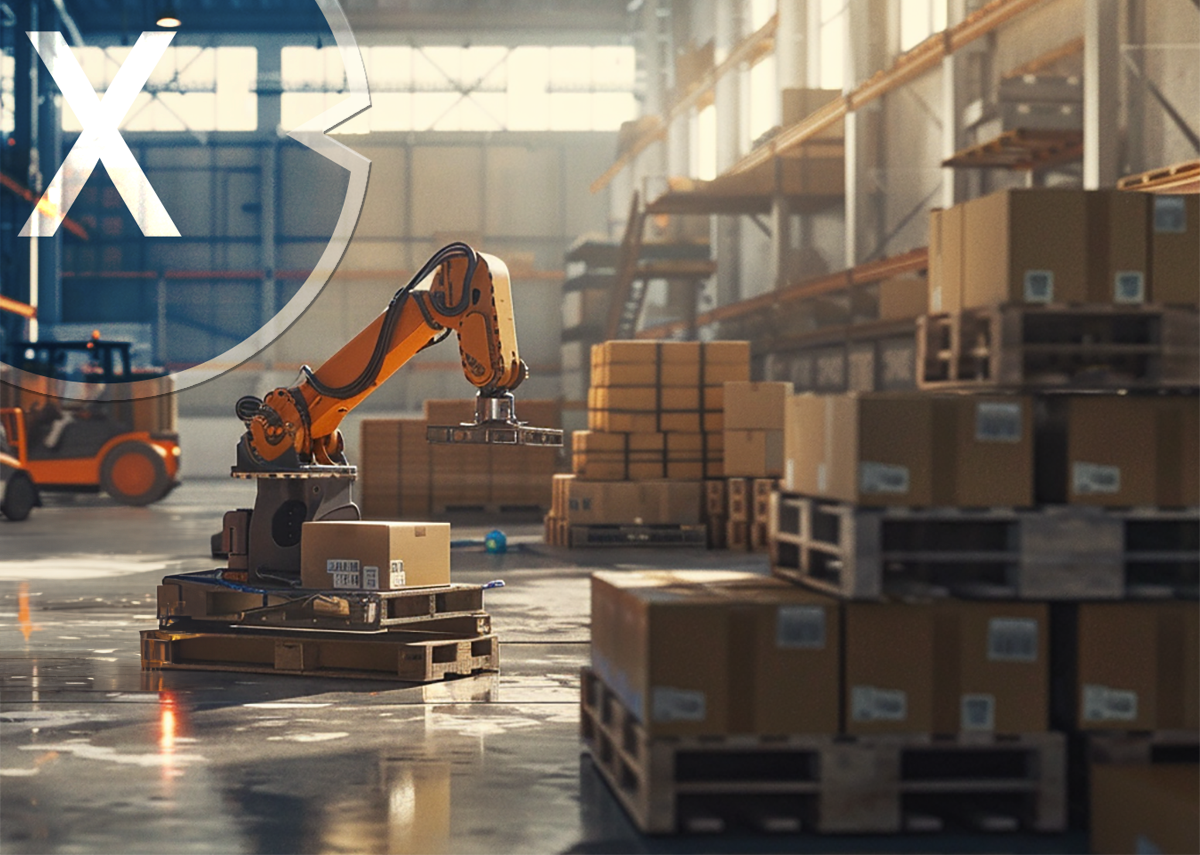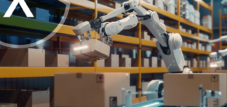
Robots and cobots during depalletizing and palletizing: Automated logistics and increased efficiency in production – Image: Xpert.Digital
📦🤖 The logistics revolution: Depalletizing and palletizing with robots and cobots
🚀 In modern logistics and production, the processes of depalletizing and palletizing play a central role. Rapid technological advancements, particularly in robotics and collaborative robots (cobots), have significantly improved the efficiency and accuracy of these processes.
🌟 The importance of depalletizing and palletizing
Depalletizing refers to the process of removing products from pallets and preparing them for further processing. Palletizing, on the other hand, refers to the orderly stacking of products on pallets for storage or transport. Both processes are crucial for smooth operations in numerous industries, from food and beverage production to automotive manufacturing. Automation and the use of robots and cobots allow these tasks to be performed not only faster but also with minimal human intervention.
🤖 Robotics in the logistics and manufacturing industry
Robots specifically designed for depalletizing and palletizing are playing an increasingly important role in modern industry. They are capable of handling heavy loads, performing repetitive tasks precisely, and doing so for extended periods without fatigue or errors. The use of robots leads to a significant increase in productivity and a reduction in labor costs.
👥 Collaborative robots (cobots)
Collaborative robots, also known as cobots, represent an innovative step in robotics. These robots are designed to work directly alongside human workers. Unlike traditional industrial robots, which typically operate in enclosed and secured areas, cobots can work in close proximity to people while maintaining safety and efficiency. A key feature of cobots is their ability to adapt to various tasks and work environments. They are easy to program and, thanks to their flexibility and user-friendliness, can be used in a wide range of production processes. This offers significant advantages for companies that do not have a large technical workforce.
💡 Advantages of automation through robotics and cobots
The integration of robots and cobots offers numerous advantages. Among the most important are:
Increased productivity
Robots can work around the clock without breaks or fatigue. This leads to a significant increase in production efficiency.
Cost savings
Automation reduces the need for manual labor, leading to significant savings in personnel costs.
Precision and consistency
Robots operate with utmost precision and consistency, minimizing errors and ensuring consistently high product quality.
Improved workplace safety
Dangerous or physically demanding tasks can be taken over by robots, which reduces the risk of workplace accidents and protects the health of employees.
flexibility
Cobots allow for rapid adaptation to changing production requirements, as they are easy to reprogram and can be used in various areas of responsibility.
📈 Examples of the use of robots and cobots
A practical example of the use of robots in depalletizing can be found in large logistics centers. Here, robotic arms equipped with special grippers are used to precisely remove boxes or other containers from pallets and place them onto conveyor belts or packaging lines. This speeds up the entire process and significantly increases throughput.
Another example is the food industry, where cobots are used in the packaging department. They are able to recognize different packaging sizes and shapes and act accordingly. This creates a flexible and efficient packaging line that can quickly adapt to changing market demands.
🔮 Future prospects of automation
Advances in robotics and artificial intelligence (AI) suggest an even more automated future. Intelligent robots will increasingly be able to take over complex tasks that previously required human intervention. With advanced sensors and AI, robots can, for example, detect damaged products and remove them before they leave the production line. This not only increases efficiency but also contributes to quality control.
🌍 Sustainability and efficiency
Another important aspect of automation is sustainability. By using energy-saving technologies and optimized workflows, production processes can be made more resource-efficient. Robots and cobots require less energy than conventional machines and thus contribute to a reduction in the ecological footprint. Furthermore, they enable more precise material use, which minimizes waste and overproduction.
🧑🏫 The role of employees
The increasing use of robots and cobots also raises questions about the role of human workers. While some tasks may become obsolete through automation, new fields of work are simultaneously emerging. Employees must increasingly focus on monitoring and maintaining the robots, as well as programming and customizing them. This requires continuous training and education to master the use of these new technologies.
📚 Training and retraining
It is becoming increasingly important for companies to invest in the training and retraining of their employees. This can be achieved through internal training programs or collaborations with educational institutions. This ensures that the workforce possesses the necessary skills to thrive in an increasingly automated work environment. The early integration of training measures helps to increase the acceptance of new technologies and alleviate fears of job losses.
⚙️ Challenges and solutions in implementation
Despite the numerous advantages, the integration of robots and cobots also presents challenges. One of the biggest hurdles is the initial investment in the technology. Highly advanced robots and cobots are expensive to purchase and require careful planning and budgeting. Furthermore, implementing an automated solution involves considerable effort, as existing processes and infrastructures must be adapted.
To overcome these challenges, companies can utilize funding programs and financial incentives offered by government agencies or private institutions. Furthermore, it is advisable to proceed step by step and initially launch pilot projects before a full-scale implementation. This allows for the gathering of experience and the early identification and resolution of potential problems.
🚀 Further developing automation
The depalletizing and palletizing process is being revolutionized by the use of robots and cobots. These technologies offer numerous advantages, including increased efficiency, cost savings, and improved workplace safety. However, implementation requires careful planning and adaptation, as well as continuous employee training. With advancements in robotics and artificial intelligence, automation possibilities will continue to evolve and significantly shape the future of logistics and production.
📣 Similar topics
- 🤖 Robots and cobots: Revolutionary technology in depalletizing and palletizing
- 📦 Increasing efficiency in logistics through automation
- 🧑🏫 The new role of employees in automated production
- 🚀 Productivity booster: How cobots are changing the world of work
- 🔧 Flexibility and precision: The use of cobots in manufacturing
- 🌐 Future vision: AI and robotics for an automated future
- 🌿 Sustainability in production through intelligent automation
- 🤝 Human-robot collaboration: A key success factor in modern industry
- 💼 Challenges in implementing robotics solutions
- 📈 Advantages of automation: Lower costs, greater safety
#️⃣ Hashtags: #Robotics #Automation #Logistics #Productivity #Sustainability
Xpert partner in warehouse planning and construction
🔄📦 Warehouse Depalletizing & Palletizing: Increasing efficiency through automation in the depalletizing and palletizing processes
The process of depalletizing and palletizing plays a central role in modern logistics and production with robotics and cobots - Image: Xpert.Digital
The depalletizing and palletizing process plays a central role in modern logistics and production. Economic considerations and ergonomic requirements, often driven by legal regulations, are increasingly leading to the use of robots in depalletizing and palletizing. These tasks can hardly be performed efficiently and economically in today's industry without automated systems.
More about it here:
Xpert.Plus warehouse optimization - high-bay warehouses such as pallet warehouses consulting and planning
We are there for you - advice - planning - implementation - project management
☑️ Smart City & Factory: Industry expert for energetic 5G buildings and halls as well as advice and installation of solar systems
☑️ Xpert.Plus - logistics consulting and logistics optimization
☑️ Industry expert, here with his own Xpert.Digital Industry Hub with over 2,500 specialist articles
I would be happy to serve as your personal advisor.
You can contact me by filling out the contact form below or simply call me on +49 89 89 674 804 (Munich) .
I'm looking forward to our joint project.
Xpert.Digital - Konrad Wolfenstein
Xpert.Digital is a hub for industry with a focus on digitalization, mechanical engineering, logistics/intralogistics and photovoltaics.
With our 360° business development solution, we support well-known companies from new business to after sales.
Market intelligence, smarketing, marketing automation, content development, PR, mail campaigns, personalized social media and lead nurturing are part of our digital tools.
You can find out more at: www.xpert.digital - www.xpert.solar - www.xpert.plus

